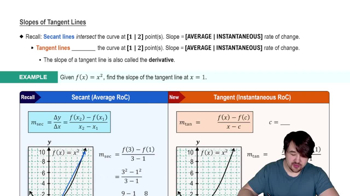Table of contents
- 0. Functions7h 52m
- Introduction to Functions16m
- Piecewise Functions10m
- Properties of Functions9m
- Common Functions1h 8m
- Transformations5m
- Combining Functions27m
- Exponent rules32m
- Exponential Functions28m
- Logarithmic Functions24m
- Properties of Logarithms34m
- Exponential & Logarithmic Equations35m
- Introduction to Trigonometric Functions38m
- Graphs of Trigonometric Functions44m
- Trigonometric Identities47m
- Inverse Trigonometric Functions48m
- 1. Limits and Continuity2h 2m
- 2. Intro to Derivatives1h 33m
- 3. Techniques of Differentiation3h 18m
- 4. Applications of Derivatives2h 38m
- 5. Graphical Applications of Derivatives6h 2m
- 6. Derivatives of Inverse, Exponential, & Logarithmic Functions2h 37m
- 7. Antiderivatives & Indefinite Integrals1h 26m
- 8. Definite Integrals4h 44m
- 9. Graphical Applications of Integrals2h 27m
- 10. Physics Applications of Integrals 2h 22m
4. Applications of Derivatives
Differentials
Problem 7`
Textbook Question
For each function ƒ and interval [a, b], a graph of ƒ is given along with the secant line that passes though the graph of ƒ at x = a and x = b.
a. Use the graph to make a conjecture about the value(s) of c satisfying the equation (ƒ(b) - ƒ(a)) / (b-a) = ƒ' (c) .
b. Verify your answer to part (a) by solving the equation (ƒ(b) - ƒ(a)) / (b-a) = ƒ' (c) for c.
ƒ(x) = x⁵/16 ; [-2, 2] <IMAGE>
 Verified step by step guidance
Verified step by step guidance1
Step 1: Understand the Mean Value Theorem (MVT), which states that for a function ƒ that is continuous on the closed interval [a, b] and differentiable on the open interval (a, b), there exists at least one number c in (a, b) such that (ƒ(b) - ƒ(a)) / (b-a) = ƒ'(c).
Step 2: Identify the function and interval given in the problem. Here, the function is ƒ(x) = x⁵/16 and the interval is [-2, 2].
Step 3: Calculate the average rate of change of the function over the interval [-2, 2]. This is given by (ƒ(b) - ƒ(a)) / (b-a), where a = -2 and b = 2.
Step 4: Find the derivative of the function ƒ(x) = x⁵/16. The derivative, ƒ'(x), is obtained by differentiating the function with respect to x.
Step 5: Solve the equation (ƒ(b) - ƒ(a)) / (b-a) = ƒ'(c) for c. This involves setting the average rate of change equal to the derivative and finding the value(s) of c in the interval (-2, 2) that satisfy this equation.
 Verified video answer for a similar problem:
Verified video answer for a similar problem:This video solution was recommended by our tutors as helpful for the problem above
Video duration:
4mPlay a video:
Was this helpful?
Key Concepts
Here are the essential concepts you must grasp in order to answer the question correctly.
Mean Value Theorem
The Mean Value Theorem (MVT) states that for a continuous function on a closed interval [a, b] that is differentiable on the open interval (a, b), there exists at least one point c in (a, b) such that the instantaneous rate of change at c (ƒ'(c)) equals the average rate of change over the interval, given by (ƒ(b) - ƒ(a)) / (b - a). This theorem is fundamental in connecting the behavior of a function over an interval to its derivative.
Recommended video:

Fundamental Theorem of Calculus Part 1
Secant Line
A secant line is a straight line that intersects a curve at two or more points. In the context of the question, the secant line connects the points (a, ƒ(a)) and (b, ƒ(b)) on the graph of the function ƒ. The slope of this secant line represents the average rate of change of the function over the interval [a, b], which is crucial for applying the Mean Value Theorem.
Recommended video:

Slopes of Tangent Lines
Derivative
The derivative of a function, denoted as ƒ'(x), represents the instantaneous rate of change of the function at a specific point x. It is defined as the limit of the average rate of change as the interval approaches zero. Understanding derivatives is essential for solving the equation in part (b) of the question, as it allows us to find the value of c where the instantaneous rate of change equals the average rate of change over the interval.
Recommended video:

Derivatives


